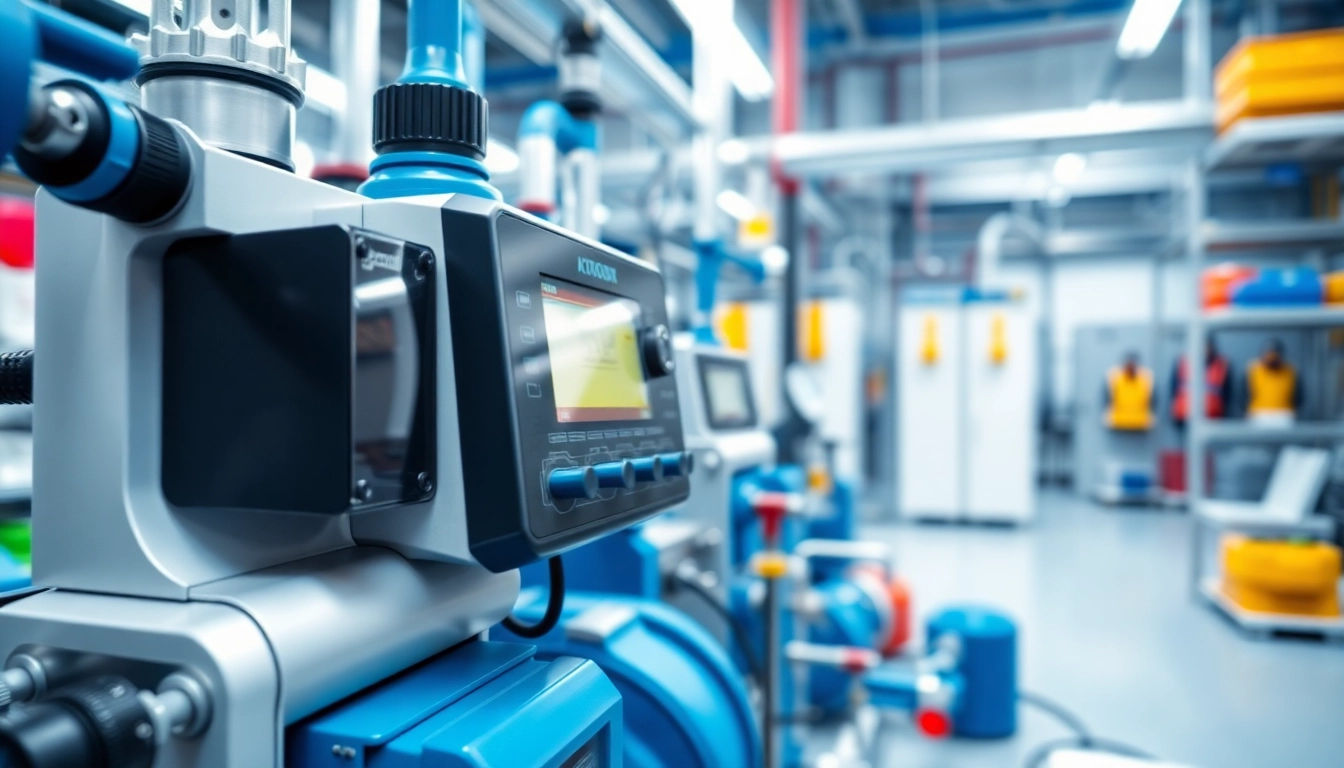Understanding Hydrogen Chloride and Its Risks
What is Hydrogen Chloride?
Hydrogen Chloride (HCl) is a colorless gas characterized by a pungent, irritating odor. It is a strong acid that, when dissolved in water, forms hydrochloric acid, an important industrial chemical. Occurring naturally in the form of a gas, hydrogen chloride plays a critical role in various chemical processes, including pH regulation and mineral processing. Its presence in industry is significant, as it is utilized in the production of chlorides, fertilizers, and various organic and inorganic compounds. Due to its highly corrosive nature, effective Hydrogen Chloride detection is crucial to ensure safety in environments where it’s present.
Health Impacts of Exposure
Exposure to hydrogen chloride can lead to a variety of health issues, depending on the concentration and duration of exposure. Short-term exposure to low levels may cause irritation of the eyes, skin, and respiratory tract, while high concentrations can be life-threatening. Inhalation may lead to serious respiratory problems, including pulmonary edema, inflammation of the airways, and in severe cases, even fatalities. Chronic exposure can affect lung function and exacerbate existing respiratory diseases. Thus, monitoring and timely detection of hydrogen chloride are essential to mitigate these health risks.
Common Industrial Applications
Hydrogen chloride is extensively used across multiple industries. Common applications include:
- Chemical Manufacturing: It is a vital reactant in the production of various chemicals such as methylene chloride and hydrochloric acid.
- Food Processing: Used in the processing of food products, hydrogen chloride can contribute to food preservation.
- Metal Processing: It is crucial in pickling processes to remove rust or scale from metals.
- Pharmaceuticals: It is employed in the synthesis and processing of active pharmaceutical ingredients.
Essentials of Hydrogen Chloride Detection
Types of Detection Technologies
The detection of hydrogen chloride can be achieved through a variety of technologies, each with unique advantages and limitations. These include:
- Electrochemical Sensors: These devices are widely used for HCl detection due to their sensitivity and low cost. They work by generating a current proportional to the concentration of hydrogen chloride in the air.
- Infrared Sensors: Capable of detecting gas concentrations in real-time, these sensors utilize infrared light absorption to measure HCl levels. They’re particularly effective in environments with varying temperatures.
- Photoionization Detectors (PIDs): These devices can detect a wide range of volatile organic compounds and gases, including HCl. They use ultraviolet light to ionize gas molecules, providing accurate readings.
Choosing the Right Detector
Selecting the appropriate hydrogen chloride detection system depends on various factors including the environment, required sensitivity, response time, and budget. Key considerations include:
- Environment: Assess if the detector will be used in a corrosive environment, as this can affect sensor durability.
- Concentration Range: Ensure the detector is capable of sensing the required range of concentrations.
- Calibration Needs: Consider how often the detector needs calibration, as this impacts maintenance costs over time.
- Documentation and Support: Ensure that the manufacturer provides ample technical support, documentation, and user manuals for troubleshooting.
Calibration and Maintenance Best Practices
Proper calibration and maintenance are vital for effective and reliable hydrogen chloride detection. Here are best practices:
- Regular Calibration: Conduct routine calibrations using known concentrations of hydrogen chloride to ensure accuracy.
- Maintenance Schedule: Follow a strict maintenance schedule to clean and check detectors for operational integrity.
- Test Replacements: Replace sensors based on manufacturer’s recommendations, typically ranging from every 6 months to 2 years.
Implementing Hydrogen Chloride Detection Solutions
Installation Processes
Implementing hydrogen chloride detection systems requires careful planning and execution. Installation steps should include:
- Site Assessment: Conduct a thorough assessment of the site, identifying potential sources of HCl and high-risk areas.
- Strategic Placement: Install sensors where hydrogen chloride is most likely to accumulate, typically at low points in the facility.
- Wiring and Connectivity: Ensure that all sensors are properly wired and connected to alert systems to ensure prompt notifications.
Integration with Existing Safety Systems
Integrating hydrogen chloride detection systems with existing safety protocols enhances overall safety. Effective integration involves:
- Communications: All detectors should connect to central alarm systems to ensure immediate alerts.
- Interfacing with PPE Protocols: Inform personnel about personal protective equipment (PPE) usage based on detection system alerts.
- Regular Drills: Conduct safety drills that incorporate the use of HCl detection systems to ensure readiness during emergencies.
Training Personnel for Effective Use
Human error can significantly undermine detection systems if personnel are not adequately trained. Training should encompass:
- Awareness Sessions: Offer sessions that detail the dangers of hydrogen chloride and the importance of detection.
- Operational Training: Teach employees how to read detector outputs and respond appropriately to alerts.
- Emergency Procedures: Ensure personnel are knowledgeable about emergency response protocols in case of an HCl leak.
Monitoring and Reporting Protocols
Real-time Monitoring Benefits
Real-time monitoring systems provide immediate data and alerts regarding hydrogen chloride levels, offering numerous benefits, such as:
- Rapid Response: Immediate alerts allow for quick actions to mitigate risks, including evacuation protocols or equipment shutdowns.
- Continuous Data Collection: Gather continuous data for comprehensive analysis of HCl exposure trends over time.
- Enhanced Accountability: Real-time data logging can help in compliance with safety regulations and procedures.
Data Logging and Analysis
Implementing data logging mechanisms provides an additional layer of safety in hydrogen chloride monitoring:
- Historical Data Review: Regular analysis of past data assists in recognizing patterns and potential risk factors.
- Operational Insights: Utilize data to optimize processes and improve safety measures based on detection analytics.
- Compliance Reports: Data logging is crucial for documenting compliance with environmental and safety regulations.
Regulatory Compliance Requirements
Understanding and adhering to regulatory compliance is crucial for safe handling and monitoring of hydrogen chloride. Compliance involves:
- OSHA Guidelines: Familiarize yourself with Occupational Safety and Health Administration requirements for HCl exposure.
- Environmental Regulations: Ensure adherence to local and national environmental safety standards covering gas emissions.
- Regular Audits: Conduct routine audits of detection systems to maintain compliance with prevailing safety regulations.
Future Trends in Hydrogen Chloride Detection
Innovations in Detection Technologies
The future of hydrogen chloride detection is promising as technology continues to develop. Emerging trends include:
- Smart Sensors: Utilization of IoT technology will enable remote monitoring and control over detection systems.
- Enhanced Sensitivity: Ongoing research is aimed at developing sensors that are more sensitive and reliable across wider temperature ranges.
- Multi-gas Detectors: Next-generation devices are being developed to simultaneously detect multiple gases, including HCl, enhancing safety in environments with various hazards.
Predictive Analytics in Safety Management
The integration of predictive analytics into hydrogen chloride detection is an exciting development. This approach allows organizations to anticipate problems before they occur. Key features include:
- Risk Assessment Models: Utilizing historical and real-time data to model potential risk scenarios, organizations can implement proactive safety measures.
- Machine Learning Techniques: Algorithms can analyze trends over time, improving prediction accuracy of HCl presence and potential leaks.
Emerging Safety Standards and Regulations
The future also brings evolving safety standards and regulations specifically designed around the management of hydrogen chloride. Staying informed about these changes is crucial for:
- Staying Compliant: Adhering to new regulations ensures continued operational capabilities without legal limitations.
- Improving Workplace Safety: As regulations evolve, so too will best practices and technology advancements to further enhance worker safety.



